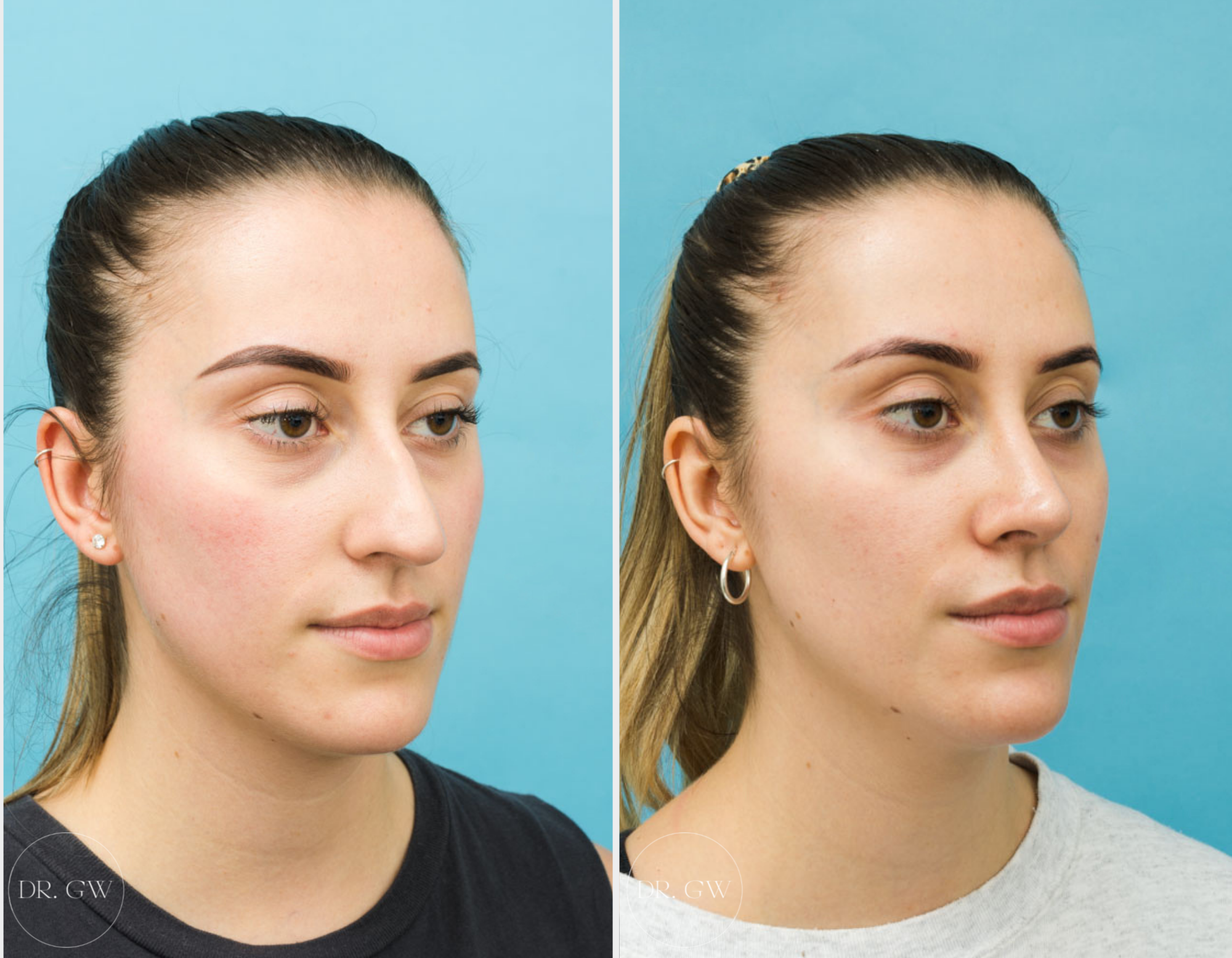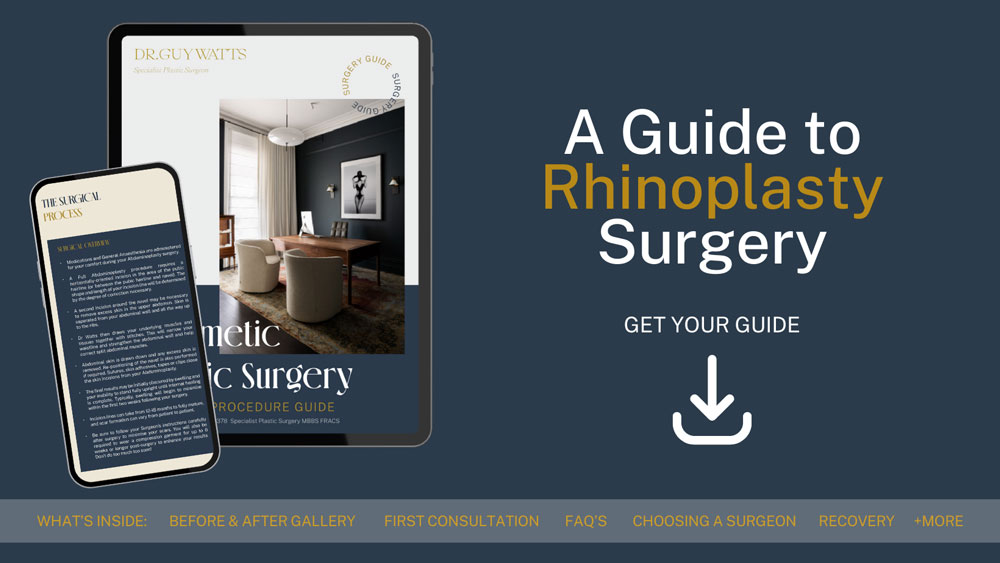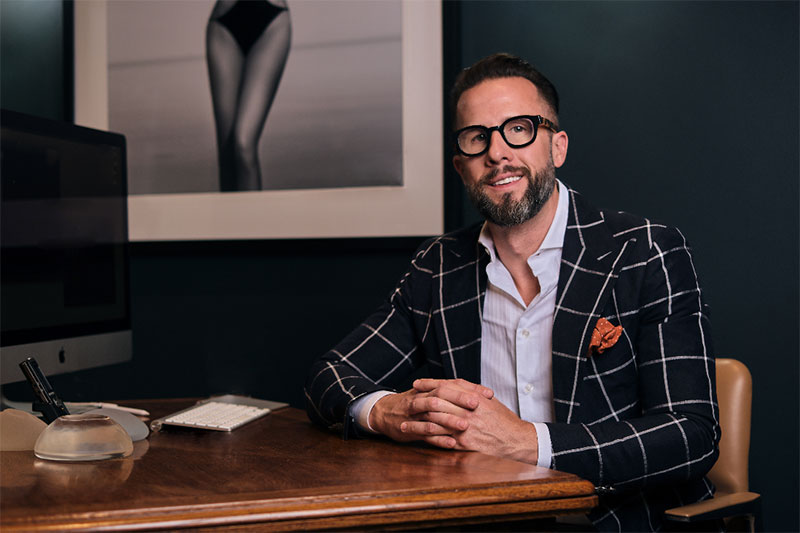
13 Jul How to Reduce Bruising after Rhinoplasty
Steps to Help Reduce Bruising Post-op
As you move through the healing stages after rhinoplasty, one common concern is the appearance of bruising around the nose and eyes. While some degree of bruising is inevitable, there are several effective strategies you can employ to reduce its severity and duration. In this blog, Perth Specialist Plastic Surgeon Dr. Guy Watts will provide you with detailed steps on how to reduce bruising after rhinoplasty, increasing your comfort during recovery.
Take our quiz, and find out if you are ready for surgery
Stages of Healing after Rhinoplasty
In order to effectively reduce bruising and support recovery after rhinoplasty, it’s essential to understand the stages of healing your body will go through. Knowing what to expect at each phase can help you take the right steps to reduce discomfort and achieve optimal results.
Day 1-3 after Rhinoplasty
- Rest and Elevation: After the surgery, you’ll likely feel groggy due to the anaesthesia. Rest is essential, and keeping your head elevated helps reduce swelling and bruising.
- Swelling and Bruising: These are most prominent around the eyes and nose. Cold compresses can help manage these symptoms.
- Discomfort and Pain Management: You may experience discomfort, which can be managed with prescribed pain medications. Avoid over-the-counter painkillers like aspirin or ibuprofen, as they can increase bleeding.
Day 4-7 after Rhinoplasty
- Follow-Up Visit: Typically, you’ll have a follow-up appointment with Dr. Watts to check on your progress and remove any initial dressings or splints.
- Gradual Changes: Swelling and bruising will start to subside, although they may still be noticeable. Continue using cold compresses and keep your head elevated.
- Avoiding Strain: It’s important to avoid any strenuous activities, bending over, or heavy lifting to prevent increased swelling or bleeding.
Week 2 after Rhinoplasty
- Reduced Swelling and Bruising: By the end of the second week, swelling and bruising should be significantly reduced. You might feel comfortable returning to work or social activities, depending on your comfort level.
- Stitches and Splints: If you have non-dissolvable stitches, they may be removed during this period. Internal splints, if used, might also be taken out by Dr. Watts.
Week 3-4 after Rhinoplasty
- Resuming Light Activities: You can start incorporating light activities into your routine but still avoid strenuous exercise.
- Continued Healing: The nose may still appear swollen, particularly at the tip. This is to be expected and will continue to dissipate over time.
- Scar Care: If you have external incisions, take care of your scars as advised by Dr. Watts. This may include using silicone gel or sheets to reduce scarring.
Month 1 after Rhinoplasty
- Swelling Reduction: Most of the noticeable swelling should have subsided, although subtle swelling, especially at the tip, can persist.
- Activity Level: You can gradually increase your activity level, including returning to more vigorous exercises. However, it’s important to avoid any contact sports or activities that risk impact to the nose.
Month 2-3 after Rhinoplasty
- Ongoing Changes: The shape of your nose will continue to change and become more defined as swelling decreases.
- Numbness and Sensation: Patients may still experience some residual numbness or altered sensation around the nose, and sensations should continue to return over time.
- Follow-Up Appointments: Regular follow-up appointments with Dr. Watts will help make sure your nose is healing and allow you to address any concerns.
3-6 Months after Your Nose Surgery
- Final Shape: While much of the swelling will have dissipated, the final shape of your nose will continue to evolve. Subtle changes can occur over several months.
- Skin and Tissue Adjustment: The skin and tissues will adapt to the new underlying structure, contributing to the final appearance of your nose.
6-12 Months after Nose Surgery
- Full Recovery: By the end of one year, the healing process is usually complete. Swelling should be entirely gone, and you’ll be able to see the final results of your surgery.
- Permanent Changes: The structural changes made during surgery are permanent. Continue to follow Dr. Watts’ advice on how to maintain the results and take care of your nose.
DOWNLOAD DR WATTS’ ULTIMATE GUIDE TO RHINOPLASTY

Steps to Reduce Bruising after Rhinoplasty
After understanding the various stages of healing following rhinoplasty, it’s time to focus on specific actions you can take to reduce bruising. Bruising is a common side effect of this surgery, but with the right care and attention, its severity and duration can be managed.
Rest and Elevation
Rest is essential after any surgical procedure, and rhinoplasty is no exception. Your body needs time to heal, and rest allows your immune system to focus on repairing tissues and reducing inflammation. During the first few days after your surgery, avoid activities that can increase blood flow to your face and head, such as bending over or vigorous movements.
Elevation Techniques
Keeping your head elevated is another crucial aspect of post-operative care. Elevation helps reduce blood flow to the nose area, which can significantly reduce swelling and bruising. Here’s how you can effectively elevate your head:
- Use Multiple Pillows: Prop your head up with two or three pillows while sleeping. This will keep your head at a 30 to 45-degree angle.
- Wedge Pillow: Consider using a wedge pillow, which provides a stable incline and can be more comfortable than stacking regular pillows.
- Recliner: If you have a recliner, sleeping in it for the first few nights can be an effective way to keep your head elevated.
Sleep Position
Sleeping on your back with your head elevated is a good position post-surgery. Avoid sleeping on your side or stomach, as this can increase pressure on your nose and potentially worsen swelling and bruising. Using pillows on either side of your head can help prevent you from turning over in your sleep.
Cold Compresses
Cold compresses are highly effective in reducing swelling and bruising. Cold constricts blood vessels, which helps prevent further leakage of blood into surrounding tissues and reduces inflammation. Here’s how to use cold compresses properly:
Application Techniques
- Soft Cloth or Gel Pack: Use a soft cloth or a cold gel pack wrapped in a towel. Direct application of ice can cause frostbite or skin damage, so always make sure there is a barrier between the cold source and your skin.
- Frequency and Duration: Apply the cold compress to the eye and cheek area for 10-15 minutes at a time. Repeat this process several times a day, especially during the first 48 hours after surgery, which is when swelling and bruising are most likely to occur.
Precautions
- Avoid Direct Contact with Nose: Do not apply the cold compress directly to your nose. Instead, focus on the areas around the nose, such as the eyes and cheeks, to avoid putting pressure on the surgical site.
- Monitor Skin Condition: Check your skin regularly to make sure there are no signs of frostbite or irritation.
- If you notice any unusual redness or discomfort, discontinue use and consult Dr. Watts.
Avoid Strenuous Activities
Engaging in strenuous activities can increase your heart rate and blood pressure, which can exacerbate swelling and bruising by increasing blood flow to the surgical area. It’s important to limit physical exertion during the initial recovery period to allow your body to heal effectively.
Activity Guidelines
- First Two Weeks: During the first two weeks post-surgery, avoid heavy lifting, intense exercise, and any activities that require significant physical effort. This includes household chores, sports, and workouts.
- Gradual Resumption: Gradually reintroduce light activities into your routine as you feel more comfortable. Walking and careful stretching can be beneficial for maintaining circulation without overexerting yourself.
- Consult Dr. Watts: Follow Dr. Watts’ specific recommendations regarding when and how to resume your regular exercise routine. Everyone’s recovery timeline is different, and Dr. Watts can provide personalised advice based on your progress.
Specific Activities to Avoid
- High-Impact Exercises: Activities like running, aerobics, and weightlifting can increase the risk of complications and should be avoided until you receive clearance from Dr. Watts.
- Contact Sports: Avoid any sports or activities that involve the risk of facial injury or direct impact to the nose, such as basketball, football, or martial arts.
Keep Your Head Cool
Exposure to heat can increase blood flow to the nose area, potentially worsening bruising and swelling. Here are some tips to keep your head cool during the recovery period:
Avoid Overheating in Showers and Saunas
- Showers: High-temperature water can cause blood vessels to dilate, increasing swelling and bruising. Take lukewarm showers to avoid raising your body temperature.
- Saunas and Steam Rooms: Steer clear of saunas, steam rooms, and spas for the first few weeks after surgery. The high temperatures in these environments can negatively impact your healing process.
Sun Exposure
- Direct Sunlight: Avoid direct sun exposure, especially during peak hours when the sun is strongest. UV rays can cause skin irritation and increase the risk of hyperpigmentation in healing tissues.
- Sun Protection: If you need to be outside, wear a wide-brimmed hat to shield your face from the sun. Additionally, use a high-SPF sunblock on your face to protect your skin. Choose a sunblock that is formulated for sensitive skin to avoid irritation.
Staying Cool Indoors
- Air Conditioning and Fans: Use air conditioning or fans to keep your living environment cool. A comfortable indoor temperature can help prevent overheating and keep swelling at bay.
- Cool Compresses: In addition to cold compresses for bruising, you can use cool cloths on your forehead and neck to help regulate your overall body temperature.
Medications and Supplements
- Prescribed Medications: Dr. Watts may prescribe medications to help manage pain and reduce inflammation. Follow his instructions carefully and avoid over-the-counter pain relievers like aspirin and ibuprofen, as they can thin the blood and increase the risk of bruising.
- Arnica Montana: Arnica Montana is a homeopathic remedy commonly used to reduce bruising and swelling. It’s available in various forms, such as topical gels and oral tablets. Consult Dr. Watts before using arnica to make sure it’s okay for you to use.
- Bromelain: Bromelain, an enzyme found in pineapples, is known for its anti-inflammatory properties. It can help reduce swelling and bruising when taken as a supplement. Again, consult Dr. Watts before adding any new supplements to your regimen.
FAQs about How to Reduce Bruising after Rhinoplasty
Can certain foods or drinks help reduce bruising after rhinoplasty?
- Yes, certain foods and drinks can aid in reducing bruising. Foods rich in vitamin C, such as oranges, strawberries, and bell peppers, can help strengthen capillaries and reduce bruising.
- Pineapple is particularly beneficial due to its bromelain content, an enzyme that helps reduce inflammation and bruising.
- Staying well-hydrated by drinking plenty of water is also important as it helps flush out toxins and supports overall healing.
Are there any herbal remedies or supplements that can help reduce bruising?
- Yes, some herbal remedies and supplements can help reduce bruising. Arnica Montana, a homeopathic remedy, is commonly used to reduce bruising and swelling. It can be taken in oral form or applied topically as a gel or cream.
- Another supplement, bromelain, found in pineapples, has anti-inflammatory properties that can help with swelling and bruising.
How long should I expect the bruising to last after rhinoplasty?
- The duration of bruising varies from person to person, but most patients see significant reduction within the first two weeks.
- Initial bruising and swelling are most noticeable in the first few days post-surgery, with substantial reduction occurring after about one week.
- Some slight bruising and residual swelling can persist for several weeks to a couple of months, depending on individual healing rates and adherence to post-operative care instructions.
Can makeup be used to cover up bruising?
- Makeup can be used to cover up bruising, but it’s important to wait until Dr. Watts gives you the go-ahead, usually after the first week when initial healing has taken place.
- When you do start using makeup, opt for products specifically designed for sensitive skin and avoid applying it directly on any incisions or areas that are still healing.
- Mineral makeup or concealers with a yellow base can be particularly effective in neutralising the purple and blue hues of bruises.
Does the type of rhinoplasty (open vs. closed) affect the amount of bruising?
- Yes, the type of rhinoplasty can impact the amount of bruising. Open rhinoplasty, which involves a small external incision, may lead to more noticeable bruising and swelling compared to closed rhinoplasty, where incisions are made inside the nostrils. However, the extent of bruising also depends on individual factors such as skin type, overall health, and the specific surgical techniques used by the surgeon.
Further Reading about Face Surgery with Perth Specialist Plastic Surgeon Dr. Guy Watts
- Read Dr. Guy Watts’ Blog about Does It Hurt to Get the Blepharoplasty Stitches Removed?
- Read Dr. Guy Watts’ Blog about Swelling and Bruising after Blepharoplasty
- Read Dr. Guy Watts’ Blog about Receding Chin – What Is It, Causes and Options
- Read Dr. Guy Watts’ Blog about Recovery after Neck Lift
- Read Dr. Guy Watts’ Blog about What Is Jaw Augmentation?
- Read Dr. Guy Watts’ Blog about Recovery after Nose Surgery
- Read Dr. Guy Watts’ Blog about Recovery After Septoplasty With Rhinoplasty
Medical References about Bruising after Rhinoplasty
- Risks and complications in rhinoplasty – PubMed
- Rhinoplasty (Nose Job): Surgery, Recovery, Before & After – Cleveland Clinic
- Rhinoplasty – Mayo Clinic
- Rhinoplasty Surgery (Nose Job) – WebMD
About Dr. Guy Watts – MED0001539378
FRACS (Plas) – Specialist Plastic Surgeon In Perth WA
Dr. Guy Watts is a Specialist Plastic Surgeon (AHPRA MED0001539378) with an extensive career that spans across renowned plastic surgery clinics worldwide. His experience has been honed through invaluable experiences at esteemed establishments such as the New York Eye and Ear Infirmary and the renowned Pitanguy Clinic in Brazil.
Having collaborated with the foremost cosmetic plastic surgeons on a global scale, Dr. Watts has chosen to return to Perth after a 17-year journey of intensive training and invaluable professional experience to bring the latest practices and technology in cosmetic plastic surgery to his patients.
Dr. Watts is a Fellow of the Royal Australasian College of Surgeons (FRACS) and a Member of the Australian Society of Plastic Surgeons (ASPS), Australasian Society of Aesthetic Plastic Surgeons (ASAPS) and the International Society of Aesthetic Plastic Surgeons (ISAPS).
Read about the potential Risks and Complications of Surgery
Read the Patient Information and Resources
About CLINISPA
Clinispa is Dr Watts’ bespoke medical clinic performing Cosmetic Aesthetic treatments. At Clinispa, we offer advanced clinical treatments in a luxurious and calming environment, tailored to support your skin’s health and appearance.
Clinispa aesthetic services are performed by Dr Guy Watts’ nursing professionals, who have a passion for and solid understanding of facial aesthetics.
All Clinispa clients are considered individually, with a personalised treatment plan consisting of advanced scientific approaches to cosmetic aesthetics. We incorporate innovative technologies in conjunction with superiorly formulated skin care.
For more information about the full range of Clinispa Aesthetic of Cosmetic Treatments visit the Clinispa website








Sorry, the comment form is closed at this time.